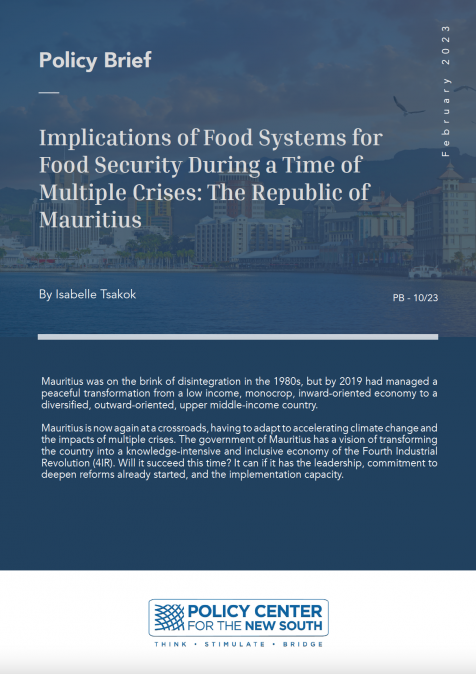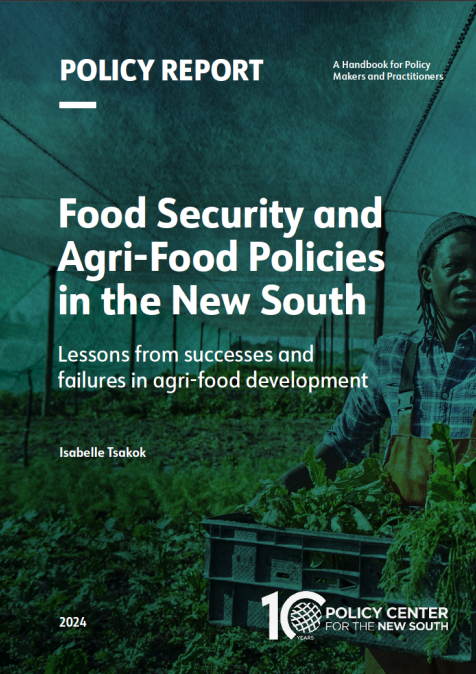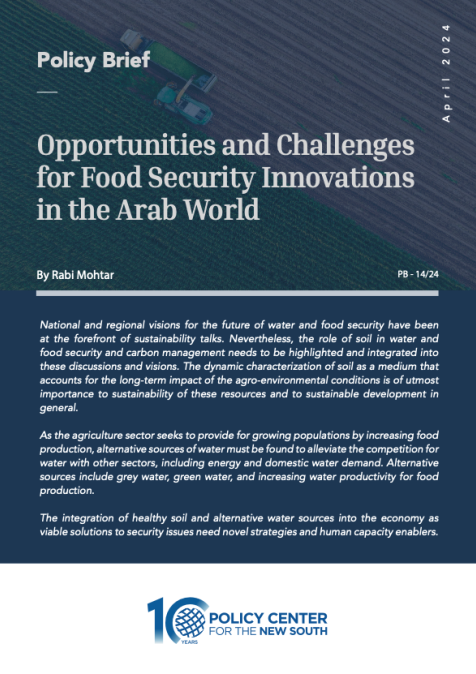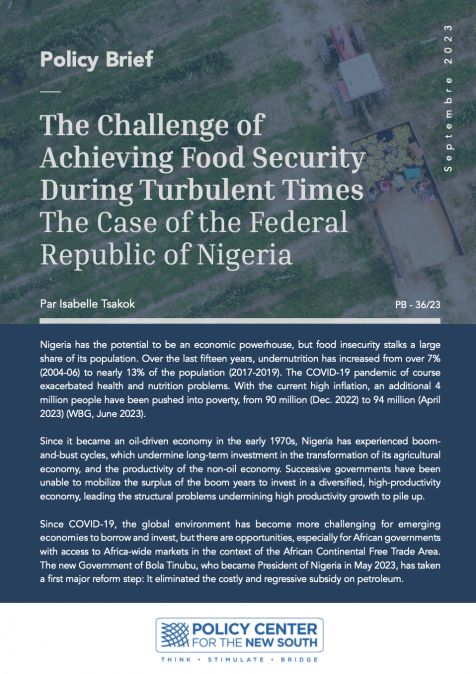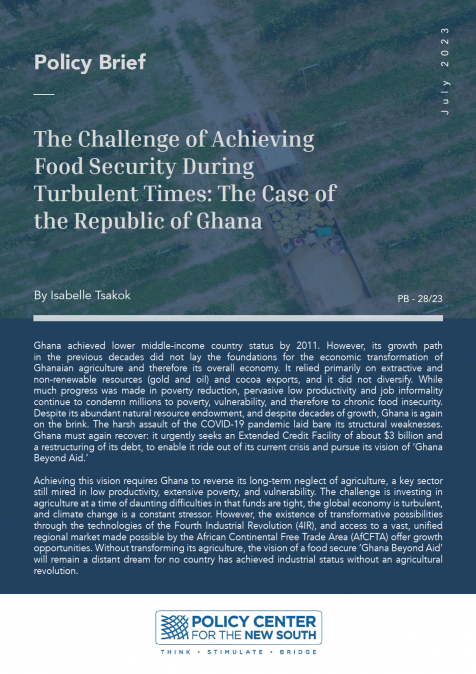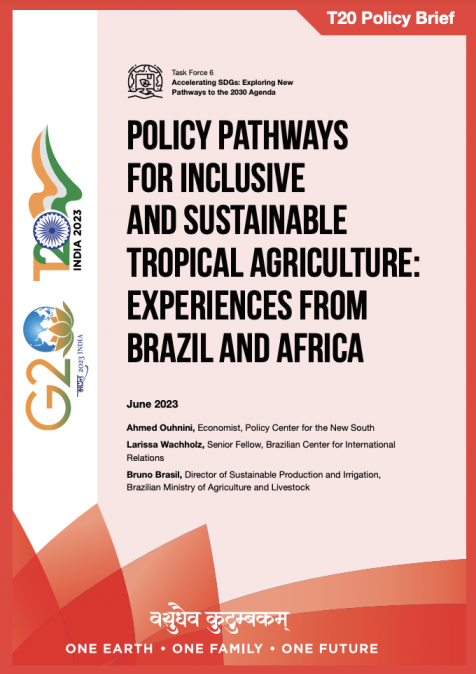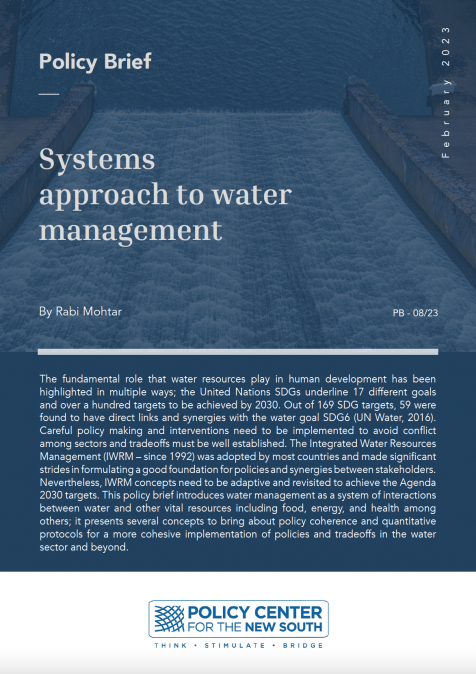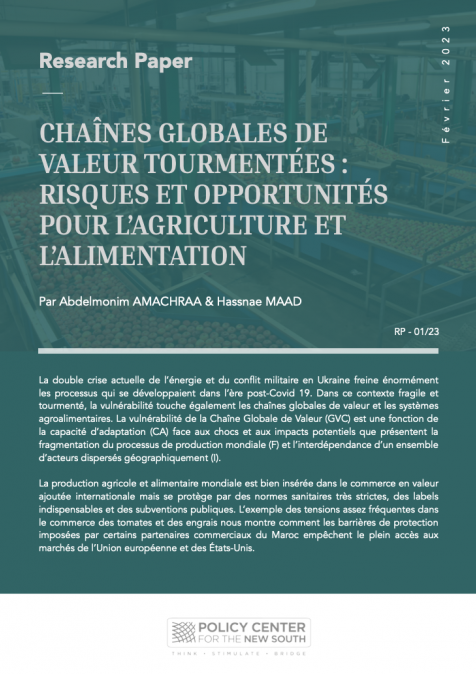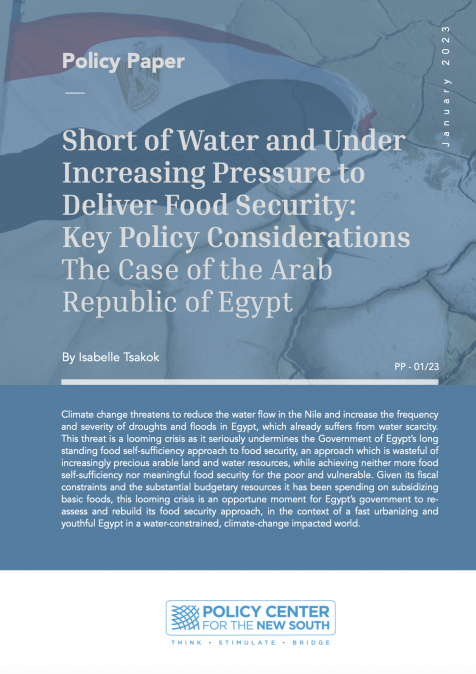Publications /
Policy Brief
Mauritius was on the brink of disintegration in the 1980s, but by 2019 had managed a peaceful transformation from a low income, monocrop, inward-oriented economy to a diversified, outward-oriented, upper middle-income country.
Mauritius is now again at a crossroads, having to adapt to accelerating climate change and the impacts of multiple crises. The government of Mauritius has a vision of transforming the country into a knowledge-intensive and inclusive economy of the Fourth Industrial Revolution (4IR). Will it succeed this time? It can if it has the leadership, commitment to deepen reforms already started, and the implementation capacity.
INTRODUCTION
The outbreak of the COVID-19 pandemic in 2020 was quickly followed by dislocations in global supply chains, and Russia’s invasion of Ukraine on Feb 24, 2022. The pandemic deepened the indebtedness of many governments requiring them to extend safety nets just as their tax revenues dwindled due to lockdowns. These multiple crises combine with the increasing frequency and severity of life-threatening weather events and continued conflict in many parts of the world,
The risk of stagflation—a combination of high inflation and sluggish growth—has increased as food and fuel inflation rise sharply, while growth is declining. Global economic prospects for a strong recovery in 2022 have been lowered to 2.9%; for sub-Saharan Africa, the growth rate is 3.7%. For the remainder of the 2020s, annual growth is expected to be below the average of the 2010s (World Bank Group or WBG, 2022). Thus, gloom and doom, worsened by increasing geo-political tensions triggered by the Russia-Ukraine war and the United States-China rivalry, characterize our times.
Mauritius is a small, open, island economy. Therefore, the global environment will inevitably impact the functioning of its economy, its food systems and its food security. This policy brief characterizes its food systems in terms of its implications for the four pillars of food security: availability, access, utilization, and stability. Each pillar is discussed in a section below. The overarching question is: What is the government of Mauritius (GoM)’s policy response likely to be to the challenges of these turbulent times, and what are the likely impacts, if any, on its food systems and its food security?
This policy brief adopts the holistic concept of food security, namely: “Food security exists when all people, at all times, have physical and economic access to sufficient safe and nutritious food that meets their dietary needs and food preferences for an active and healthy life” (FAO, 1996).
The Republic of Mauritius: GNI/cap US$ 9, 920 (2021, current $, Atlas Method) (WDI)
Section I: Brief Background—From a Monocrop to a Diversified Economy
Post-independent Mauritius was on the brink of disintegration: At independence from the United Kingdom on March 12, 1968, Mauritius was a low-income country: its GNP per capita was around $260. The post-independence environment was marked by large- scale unemployment, the rise of the Movement Militant Mauricien (MMM) in 1969, and strikes by sugar workers in 1970 and by dock workers in December 1971. In the 1970s, sugar cane occupied 45% of the total area or 88% of the cultivated area. The sugar cane sector contributed to over 31% of total employment and 23% of GDP in 1976. Although Mauritius was able to benefit from the large quota (80% of its exports) it had with the European Economic Community (EEC), under which it was able to obtain three times the then free market world price, the Mauritian economy did not do well: it grew at an average yearly rate of 1.8% (around 1964 to 1972). The labor force expanded at about 3% per year, even though annual population growth declined from around 3% (1950s to early 1960s) to around 1.5% per year (by early 1970s), as a result of a vigorous family planning program, supported by all the religious leaders. The unemployment rate was about 16% by 1972, despite employment growing by about 3% per year between 1968 to 1972.
When on the brink, Mauritius chose to diversify and grow: Mauritius was reeling under repeated balance-of payments crises and macroeconomic mismanagement as it suffered a 30% drop in sugar prices in 1976, and a second oil price shock in 1979. The budget deficit reached 14% GDP in 1980/81 (World Bank, 1985). The country’s external debt tripled between 1976 and 1979, thus increasing the debt-service ratio from 1% to 10% (World Bank, 1989). In partnership with the Bretton Woods institutions, Mauritius radically restructured its monocrop economy. To diversify, key measures included (World Bank, 1985):
-
Sugar-sector restructuring: Tax reform and factory rationalization—the tax reform provided some financial relief to the sugar industry and encouraged the sale of sugar cane lands;
-
Diversification away from sugar: Increase productivity to the maximum extent on all non-sugar lands to reach self-sufficiency in selected food crops (e.g., potatoes, most green vegetables), and to reduce dependence on imported meat and milk.
-
Export-oriented manufacturing: Re-orient external trade policy and the system of incentives (including wages and exchange rates) to improve the competitiveness of all labor-intensive firms capable of exports and of attracting FDI in the Export Processing Zone (EPZ established in 1971);
-
Tourism: Expand air access and increase hotel capacity through new private investments;
-
Energy: Invest in energy through a major expansion of the use of bagasse, a sugar by- product.
Timely reforms successfully transformed agriculture and diversified the economy: The timing of these reforms was opportune as they enabled Mauritius to take full advantage of the recovery in the world economy starting in early 1980s. The cane cluster played a pivotal role in the economy’s overall transformation through diversification within the cane cluster itself—conversion of bagasse into electricity and production of special sugars—and through its powerful linkage effects. The surplus funds generated by the sugar subsector promoted diversification partly through investment in other sectors, including hotels and tourism, and partly through a sugar export tax (Sobhee and Rajpati, 2013). During the transition period, the primary sector’s contribution (agriculture, forestry and fishing) dwindled from around 23% in the late 1970s, to 3.4% of GDP in 2013 (Govt. of Mauritius, 2016). The GoM was able to create and maintain the five necessary conditions for the successful transformation of agriculture (Tsakok, 2011): macro and price stability; effective technology transfer to both the sugar industry and non-sugar agricultural activities; access to lucrative markets; a system of private property rights and tenure security that reward individual initiative and toil; and employment-creating non-agricultural sectors (Sobhee and Rajpati, 2013). Agricultural sector employment shrunk as agriculture was successfully transformed: to around 8% of total employment (2012). Growth was principally powered by sugar, manufactured exports, tourism, and increasingly by financial, information and business services. Between 1983 and 1988, per-capita income nearly doubled, the unemployment rate fell—from 11% in 1980 to 5% in 1986—as the EPZ8 industries grew at an average annual rate of 28%, the debt-service ratio fell, and the overall fiscal deficit was reduced from 9% to 3% (World Bank, 1989).
Shared vision of an inclusive society essential in successful diversification: In the words of Sobhee and Rajpati (2013), Mauritius thrived because of “the shared vision of the public and private sector on a mode of development, where the public sector facilitates development and ensures that there is a fair distribution of wealth whilst the private sector is able to optimize its entrepreneurial and innovative skills” (Sobhee and Rajpati, 2013). Thus, despite wide ethnic and cultural diversity, and despite sharp domestic political differences, Mauritius was able to maintain a united front in negotiations affecting all parties—large and small producers and factory owners—in the major sugar sector. This shared vision was essential for its success. It was strengthened by respect for the rule of law which made possible “the synergy between public and private sectors... in terms of using private businesses to pursue government strategies” (Sobhee and Rajpati, 2013). This vision of shared wealth was critical in the treatment of employees laid off when the sugar industry was re-structured in 2001 and 2007 in response to reform of the EU Sugar Regime. Mauritius was considered to be in the 75-90 percentile range for the rule of law, indicating low risks of expropriation. Mauritius defied the dire predictions of the Tittmus-Meade reports (1961) that the “outlook for peaceful development [of Mauritius] is weak” (Stiglitz, 2011).
Section II: Determinants of Availability—Supply Side: Status and Issues
Mauritius became sugar dependent economy under French rule10: For centuries (circa 1500- 1968), Mauritius was successively colonized by the Portuguese and the Dutch, (1507-1710), then by the French (1715-1810), and the British (1810-1968). It was only under the French governor, Mahé de Labourdonnais (1735-40)12 that sugar cane became the main economic crop. Under his rule, the French landlords made sugar cane the backbone of the economy: they imported slaves from Madagascar and Mozambique, and used Indian and Chinese indentured labor, especially after slavery was abolished in 1835. Under Labourdonnais’ vigorous leadership, food self-sufficiency was promoted and even economic diversification into cotton, manioc, and coffee. He established a sugar research plantation of his own, and a sugar production factory was opened in 1744. Sugar cane won out as the main cash crop given its natural advantages—Mauritius has rich volcanic soil and a tropical climate—and imported labor.
Increase productivity and production of non-sugar agriculture though Mauritius is import- dependent for most of its staple foods: As a complement to diversifying away from sugar, the GoM has been promoting self-sufficiency in foods that can be produced locally. Mauritius is a net food importer, importing around 77% of its total food requirements. Its main imports are wheat flour, rice, milk, meat, and temperate fruits—thus primarily basic foods. Other than sugar, its only other agri-food export (which is minor) is tea. Food crops cover an estimated 4,300 ha in a total production cropped area of 8,200 ha as a result of multiple cropping (Govt. of Mauritius, 2016). An estimated 8,000 small-scale farmers, each cultivating 0.25 ha, dominate the food-crop subsector. The corporate or sugar subsector has also diversified into agri-food, including venison, poultry, animal feed, and milk products. Although there is irrigation, the food crop subsector is mainly rain-fed, producing a wide range of vegetables, in which Mauritius is totally self-sufficient. Mauritius is also well known for its tropical fruits which include mangoes, litchis, pineapples, papayas, and coconut. During the pandemic, with supply chains disrupted, the Ministry of Agro-industry and Food Security (MAIFS) did its best to increase its buffer stock of potatoes, onions, and garlic. The Agricultural Marketing Board (AMB) was able to diversify storage of strategic crops and kept the nation supplied at all times. It was also able to release commercially promising, high-yielding varieties of commonly consumed vegetables, including potatoes, onions, taro, tomato, and avocado (MAIFS, 2020-2021).
Exploit Mauritius’ ocean economy and develop the vast food potential of fisheries:
Mauritius is a small island with vast territorial waters, which includes the Offshore Banks of the Mascarene Underwater plateau, and several undersea ridges which are about 50 times the land size area of Mauritius. As depicted in The Ocean Economy: A Roadmap for Mauritius, Mauritius sees the ocean as the next frontier for its diversification/transformation (Degnarain, 2014). Currently, artisanal fisheries contribute only 1%-2% of GDP, but the contribution of the entire fisheries value chain, which includes processing and marketing, is about 4% of GDP. Artisanal fisheries, lagoon and off-reef, are an important source of employment for unskilled labor, and exclusively serve the domestic market. Industrial fishing in Mauritian waters is mainly done by foreign fleets. The ocean economy (OE) is broader than fisheries. The contribution of traditional sectors to the OE consists of sea food fishing and processing, port-related activities, tourism and related activities, and government bodies related to OE. These sub-sectors totaled 10.45% of GDP (2012-14). A doubling of OE’s contribution—referred to the O2 strategy—is possible, but it will take at least 15-18 years of substantial investments. However, even within the first 10 years, the O2 strategy can yield substantial economic growth, including a 62% increase in OE GDP, or a 38% increase in OE’s share in the national total, from around 12.6% to 17.5% of GDP (Cervigni and Scandizzo, 2017).
Climate change threatens agro-industrial production and productivity: Adverse agro- climatic events have been increasing in frequency and severity. Mauritius is among the top 10% of countries most exposed to natural disasters. Mean annual temperature already increased by 0.6o C between 1960 and 2006. It is projected to increase by 1o C to 2o C by the 2060s. With increasing temperature, the threats of new pests and diseases increase. Rainfall in the last quarter of the year declined over the 1960-2006 period by 9% per decade. Extreme precipitation and flooding will likely increase. These could cause inundation and abandonment of cultivated areas, intensifying soil erosion, and the leaching of nutrients. Droughts are also increasing. The worst droughts occurred in 1999 and 2011, the former causing a 44% plunge in the contribution of sugar to the economy (WBG, 2015). In this precipitation and temperature scenario, yields and production would fall. The GoM fully recognizes the critical importance of agricultural research and extension to assist smallholders in adopting new ways to improve the resilience of their food systems. An example of how to further this aim is a project of the United Nations Country Team in Mauritius with the Seychelles team to mobilize funding for to build resilient food systems in both countries by producing low-cost bio-fertilizers from seaweeds in Mauritius. In so doing, the two islands will be less dependent on imported fertilizers, which are more vulnerable to foreign supply shocks and dislocations, which have increased since the pandemic and the Russia-Ukraine war (Norbert, 2022). Fortunately, Mauritius has nation-wide network of research and extension offices manned by qualified professionals, although the system can be improved (MAIFS, 2020-2021).
Section III: Determinants of Access—Demand Side: Status and Issues
COVID-19 dealt a serious blow to an already stagnating Mauritian economy: Mauritius suffered a double-digit recession in 2020—the economy contracted by 14.9% (compared to expected growth of 3%-4%), mostly due to the severe lockdown imposed from March to May 2020, and to the virtual closedown of tourism which accounted for 7% GDP in 2019, and declined by 67% in 2020. The unemployment rate for the 16 to 64 age group rose from 7.2% to 10.4% between the first quarter and December 2020. The tourism decline led to severe contractions in the closely linked sectors of transport and recreational services, of -29% and -32% respectively. Mauritius’s high-income status of $12,130 per capita (2019) was knocked down to $9,940 (2020) (WDI). The GoM responded with a massive support program of roughly 32% of GDP (if fully implemented), which prevented widespread bankruptcies. The pandemic blow highlighted structural weaknesses of a stagnating economy, including (World Bank Group, 2022):
-
Stagnating capital productivity in a growth driven mainly by consumption as private- sector investment declined;
-
Loss of export competitiveness as reflected by a declining market share in its traditional exports;
-
Increasing friction in the labor market resulting in structural unemployment and inactivity;
-
Rising skills shortages, and the exclusion, in particular, of low-educated women and young people;
-
An ageing population, which will be demanding more pension support in an already constrained fiscal space; and
-
Continuous fiscal deficits aggravated by the need for fiscal support during the pandemic, resulting in rising levels of debt to GDP.
Decades’ worth of progress on poverty reduction brutally reversed by the pandemic: Mauritius is rightly lauded as a development success story in terms of poverty reduction. At independence, it was a low-income country with high unemployment. However, by 2012, nobody lived below $1.25/day, and less than 1% lived below $2.00/day. According to Mauritius’s national poverty line, poverty had declined from 8.5% (2007) to 6.9% (2012) (WBG, 2015). Between 2012 and 2017, Mauritian households experienced vigorous consumption growth as per-capita consumption increased at an annual rate of 2%. For the bottom 40%, annualized per-capita consumption grew at 2.7%, 0.7% faster than the general population. The Gini measure of inequality, which had risen from 35.7 (2006) to 38.5 (2012),
fell to 36.8 (2017). This reduction in inequality was aided by public transfers which mitigated rising wage-income inequality. Key anti-poverty measures included the Social Integration and Poverty Act of Dec 2016, Social Aid and Marshall Plan Social Contract programs, a negative income tax of 2017, a minimum wage of 2018, and a Special Allowance of 2019, on the eve of the pandemic. Had the government not protected the population against the onslaught of the pandemic, poverty would have increased to 15.9% (WBG, 2022). GoM’s anti-poverty measures and pandemic response definitely helped sustain Mauritians in their hour of need.
Section IV: Determinants of Utilization: Nutrition and Health
Choice of an inclusive growth path has generated broad-based socio-economic benefits: The transformation of Mauritius has generated broad-based socio-economic benefits, including improved life expectancy at birth, reduced infant mortality, 100% access to healthcare services, safe potable water, and reduced illiteracy, including for females. With extreme poverty at less than one percent, Mauritius has also succeeded in creating a large middle class, 80% of its population (World Bank, 2015) Achievements on the health front are also impressive as universal access to healthcare services is viewed as a human right in Mauritius. Mauritius has a public health system financed from general revenues, which provides services without user fees, premiums, or other prepayment schemes. “Government is committed to providing universal, accessible and quality health care services, free of any user cost with emphasis on customer satisfaction” (Government Program, 2015-2019). While everyone can access it, in reality the healthcare system serves mainly the poorer population, as half of total health expenditure is spent in the private sector on health insurance and out-of-pocket payments for care and treatment. Universal healthcare access has been a major contributor to good health indicators, which are comparable to other upper middle-income countries in terms of life expectancy, mortality rates for infants and children under 5, immunization coverage (100 %), and low communicable diseases rates, e.g., the eradication of malaria, and an HIV infection prevalence rate of 0.97%. Mauritius launched a vigorous integrated system for the control of communicable diseases. The progress made is reflected in the increased scores—from 55 to 75 between 2013 and 2017—of the Joint External Evaluation (JEE). Public hospital services represent the largest item of public health expenditure, representing around 82% of the annual budget of the Ministry of Health and Quality of Life. Of concern, however, is the high rate of non-communicable diseases (NCD). For example, according to the 2009 NCD survey, one in every two Mauritians aged 25-74 has diabetes or pre-diabetes. Half the population is either overweight or obese, and the prevalence of hypertension is 38%. Health and socio- economics are inevitably tied as lower levels of education are associated with more poverty and higher incidence of NCD.
The pandemic highlighted the key importance of reducing inequality for continued broad- based socio-economic progress: Despite the GoM’s substantial financial support to counter the contractionary impact of COVID-19 lockdowns, those in informal work, self-employment, or no employment were hurt disproportionately21. Government transfers helped substantially but were not able to counteract the negative impacts of unemployment, informality, or low wages. More of the poor and vulnerable are: (i) structurally unemployed; (ii) unskilled labor working in the informal sector (e.g., low-paying domestic services); (iii) unskilled work in labor-intensive sectors like agriculture, and textiles; (iv) have low levels of education22; and (v) come from large households23 (WBG, 2015). In short, the main determining factors for being poor and vulnerable are the low level of education, and related low skills. More generally, the bottom 40% lags in terms of educational achievements. These deficiencies close the door to higher paying jobs in knowledge-intensive occupations. In December 2020, nearly 69% of the self-employed, and 20% in wage employment, reported a decline relative to their pre-pandemic income levels (WBG, 2022). The main cause of the increased income inequality during the 2006-12 period, in contrast to the decrease in income inequality during the 2012-17 period, was wage differentials between the high versus low-skilled workers. Thus, the pandemic has laid bare that the great divide in the labor market is in terms of education and skill levels. These constitute the main sources of income inequality, which in turn is the major factor determining whether growth is inclusive or divisive.
Section V: Determinants of Stability: Macro, Trade, and Resilience
Mauritius reeling under, but recovering from, the historic shock of COVID-19: Mauritius suffered a 14.9% contraction in 2020 (compared to expected 3%-4% growth), but is expected to grow by 5.8% in 2022 (World Bank, Overview, 2022). The GoM’s rapid health, economic, and financial response to the first outbreaks in early 2020 meant Mauritius was ‘COVID-19 free’ from April 2020 to March 2021, when a second outbreak occurred. The GoM’s rapid response meant that by 2021, Mauritius had recorded only 315 cases of COVID-19 infections and 10 deaths (AfDB: Mauritius, 2021). Being a small open economy, Mauritius inevitably suffered from downturns abroad: (i) supply chain dislocations in East Asia; (ii) Russia’s invasion of Ukraine and subsequent global food, fuel, and fertilizer inflation; (iii) the collapse of global tourism; and (iv) the precipitous drop in demand for textiles from the EU and the United States. Thus, exports fell (-36.3%), household consumption fell (-16.8%), and investment fell (-26.7%) (WBG, 2021). Inflation was however high in 2022— thus the headline inflation rate at end-June 2022 reached 8%, compared to 2.2% in June 202124 (Government of Mauritius, 2022). Increases in the prices of widely consumed items, including rice, meat, and fish, contributed to rising inflation. On the other hand, prices of fresh vegetables and culinary herbs fell. Recovery in 2023 will be particularly challenging given the high fiscal cost of pandemic relief: GoM committed roughly 32% of GDP to various schemes in its social safety net (WBG, 2022). Now, more than ever, Mauritius needs to grow, recover vigorously, inclusively, and do more with less.
Deepen regional market integration through the AfCFTA to power its transformative growth: To recover and grow vigorously, Mauritius should exploit the timely opening of continental Africa’s huge market. Mauritius has already been recognized as the most business-friendly and competitive economy in sub-Saharan Africa25. It has upgraded its port and airport facilities, and has expanded its ICT sector to make Mauritius a regional hub for container transshipment and business process outsourcing (BPO) services. But its current management and operational use of this infrastructure needs to improve, as such use is undermining competitiveness and limiting job creation. Reforms are needed to liberalize air transport, increase the operational efficiency of cargo handling, and make available the international bandwidth necessary for Mauritius to deepen its regional market integration. As discussed above, lack of secondary and tertiary education, and of high skill levels among Mauritian workers, have been identified as a major business concern, in addition to an intergenerational poverty problem, a major source of inequality and potentially, a socially destabilizing factor.
Conclusion
The brutal assault of COVID-19, followed by multiple crises in quick succession, have highlighted both the strengths and weaknesses of the Mauritian development model in general, and the status of its food security in particular. The strengths are: (i) the GoM’s forceful and caring response to the crisis: containing the spread of the virus as early as March 2020, and supporting those physically and financially afflicted; (ii) the cohesion of the island nation under crisis—the public followed the pandemic protocol, even though the experience was personally unpleasant at times; and (iii) though food-import dependent and there was inflation, non-sugar agriculture and the government’s buffer stocks have been able to deliver sufficient food. Inflation did not turn into a food crisis.
The main weaknesses are twofold. First is the high fiscal cost of the pandemic response of delivering social assistance. This is not sustainable. To increase its resilience in the context of climate change and to be ready for further calamities, a developmental state like Mauritius must develop its resource base, administrative capacity, and mechanisms needed to respond. Second, the impact of the pandemic has been highly uneven, with the poor and vulnerable being hurt disproportionately. This uneven impact is largely due to sharp skill disparities—that is, a substantial portion of Mauritius’s labor force, which is uneducated and unskilled, is incapable of obtaining good-paying, knowledge-intensive jobs. Since the leadership’s vision is to transform Mauritius into a knowledge-intensive economy of the 4IR, it is imperative for the GoM to invest in the human capital of the poor and vulnerable. The continued peaceful development of Mauritius may well depend on it being inclusive.
Bibliography
- Ackbarally, Nasseem. Aug. 19, 2015. “Sugar trade hit as trade deals expire”. African Business, Mauritius, Agribusiness and Manufacturing. https://african.business/2015/08/agribusiness-manufacturing/ expiring-trade-deals-hit-sugar-trade/
- African Development Bank (AfDB). 2021. “Mauritius Economic Outlook: Recent macroeconomic and financial developments.” https://www.afdb.org/en/countries/southern-africa/mauritius/mauritius- economic-outlook
- Capacity for Disaster Reduction Initiative (CADRI) 2020. Mauritius Capacity Diagnosis Report. United Nations and Mauritius. https://www.cadri.net/system/files/2021-06/Mauritius%20Capacity%20 Diagnosis%20Report%20-%202020%20-%20Final.pdf
- Cervigni, Raffaello, and Pasquale Scandizzo (eds). 2017. The Ocean Economy in Mauritius: Making it Happen, making it last. Conference Edition. World Bank Group. https://documents1.worldbank.org/ curated/en/193931508851670744/pdf/120633-WP-PUBLIC-329p-Mauritius-text-10-20-17-web.pdf
- Degnarain, Ashvin. May 2014. “The Ocean Economy: A Roadmap for Mauritius”. SPC-EU Deep Sea Minerals Project, Regional Training Workshop on Deep Sea Minerals: Financial Aspects, 13-16 May, 2014. The Rarotongan Hotel, Rarotonga, Cook Islands. https://dsm.gsd.spc.int/public/files/meetings/ rartonga.may.2014/01_AshvinDegnarain_Mauritius_Presentation.pdf
- Europa. Dec. 18, 2018. “The European Union and the Republic of Mauritius step up their partnership in climate change”. https://www.eeas.europa.eu/node/55628_en
- Republic of Mauritius. Ministry of Health and Quality of Life. Y. Ramful. Lead Health Analyst. “Financing Health in Africa: Challenges and Opportunities”. Collaborative Africa Budget Reform Initiative. (CABRI). https://www.cabri-sbo.org/uploads/files/Documents/seminar_ presentation_2015_mauritius_ ministry_of_health_value_for_money_health_ english_2.3_universal_health_coverage_mauritius.pdf.
- Government of Mauritius. Ministry of Agro-Industry and Food Security (MAIFS). Jan 2016. “Strategic Plan (2016-2020) for Food Crop, Livestock, and Forestry Sectors.” https://d1bf23g64f8xve.cloudfront. net/sites/default/files/downloads/policy-database//MAURITIUS%29%20Strategic%20Plan%20for%20 the%20Food%20Crop%2C%20Livestock%20and%20Forestry%20Sectors%20%282016-2020%29.pdf
- Government of Mauritius. Ministry of Agro-Industry and Food Security (MAIFS). 2021. Annual Financial Report for Financial Year 2020/2021. https://agriculture.govmu.org/Documents/Annual%20Report/ Ministry%20of%20Agro-Industry-Annual%20Report%202020-2021.pdf
- Government of Mauritius. Ministry of Finance, Planning and Development. July 14, 2022. Consumer Price Index, 2nd Quarter, 2022. https://statsmauritius.govmu.org/Pages/Statistics/ESI/CPI/CPI_2Qtr22. aspx
- Koch, Thomas. 1989. The Sugar Protocol: An Appraisal. Intereconomics, ISSN 0020-5346, Verlag Weltarchiv, Hamburg, Vol. 24, Iss. 6, pp. 293-297. https://www.econstor.eu/bitstream/10419/140214/1/ v24-i06-a07-BF02924737.pdf
- Norbert, Jean-Yan. Sept. 02, 2022. “Building the Resilience of Food Systems in Mauritius and Seychelles by leveraging on Sustainable Agricultural Practices.” UNDP Mauritius and Seychelles. https://www.undp.org/mauritius-seychelles/news/building-resilience-food-systems-mauritius-and- seychelles-leveraging-sustainable-agricultural-practices
- Stiglitz, Joseph E. March 07, 2011. “The Mauritius Miracle”. Project Syndicate. https://www.project- syndicate.org/commentary/the-mauritius-miracle-2011-03
- Sobhee, Sanjeev K, and B. Rajpati. June 2013. Rethinking of the African Agricultural Sector and Rural Transformation in the Global Context: Challenges, Opportunities and Policy Options—the Case of Mauritius https://www.academia.edu/36111891/ RETHINKING_AFRICAS_AGRICULTURAL_AND_ RURAL_ TRANSFORMATION_IN_THE_GLOBAL_CONTEXT_ CHALLENGES_OPPORTUNITIES_ AND_STRATEGIC_ POLICY_OPTIONS_THE_CASE_OF_MAURITIUS
- Tsakok, Isabelle. 2011. Success in Agricultural Transformation: What it means and What makes it Happen. Cambridge University Press.
- World Bank. April 11, 1985. Mauritius: Adjustment and Growth—Country Economic Memorandum. Report # 5533-MAS. https://documents1.worldbank.org/curated/en/415551468281693058/pdf/ multi0page.pdf
- World Bank. July 10, 1989. Mauritius: Managing Success. Report # 7661-MAS. Eastern Africa Department, Africa Regional Office. https://documents1.worldbank.org/curated/en/988511468110073811/pdf/ multi0page.pdf
- World Bank Group (WBG). June 25, 2015. Mauritius Systematic Country Diagnosis. Report # 92703-MU https://openknowledge.worldbank.org/bitstream/handle/10986/23110/ Mauritius000Sy0c0Country0Diagnostic.pdf?sequence=1&isAllowed=y
- World Bank Group (WBG). Sept 2015. Mauritius: Inclusiveness of Growth and Shared Prosperity. https://openknowledge.worldbank.org/handle/10986/23804
- World Bank. April 20, 2017. Country Partnership Framework for Mauritius, for the Period FY 17-21. Report #: 112232-MU. https://documents1.worldbank.org/curated/en/648161499047236511/pdf/ Mauritius-CPF-Final-05022017.pdf
- World Bank Group. (WBG) April 2021. Mauritius: Through the eye of a perfect storm—Coming back stronger from the COVID crisis. A World Bank Group Country Economic Memorandum. https:// documents1.worldbank.org/curated/en/586691621628367648/pdf/Mauritius-Through-the-Eye- of-a-Perfect-Storm-Coming-Back-Stronger-from-the-COVID-Crisis-A-World-Bank-Group-Country- Economic-Memorandum.pdf
- World Bank Group. (WBG) Jan 2022. Mauritius Systematic Country Diagnosis—(SCD) Update. Report # 168362-MU. https://openknowledge.worldbank.org/bitstream/handle/10986/37180/Mauritius- Systematic-Country-Diagnostic-Update.pdf?sequence=1&isAllowed=y
- World Bank. June 2022. Global Economic Prospects. Washington D.C. https://openknowledge. worldbank.org/handle/10986/37224
- World Bank. Overview. Last updated Oct. 07, 2022. https://www.worldbank.org/en/country/mauritius/ overview
- World Development Indicators (WDI) Mauritius. Atlas method. https://data.worldbank.org/indicator/ NY.GNP.PCAP.CD?locations=MU

